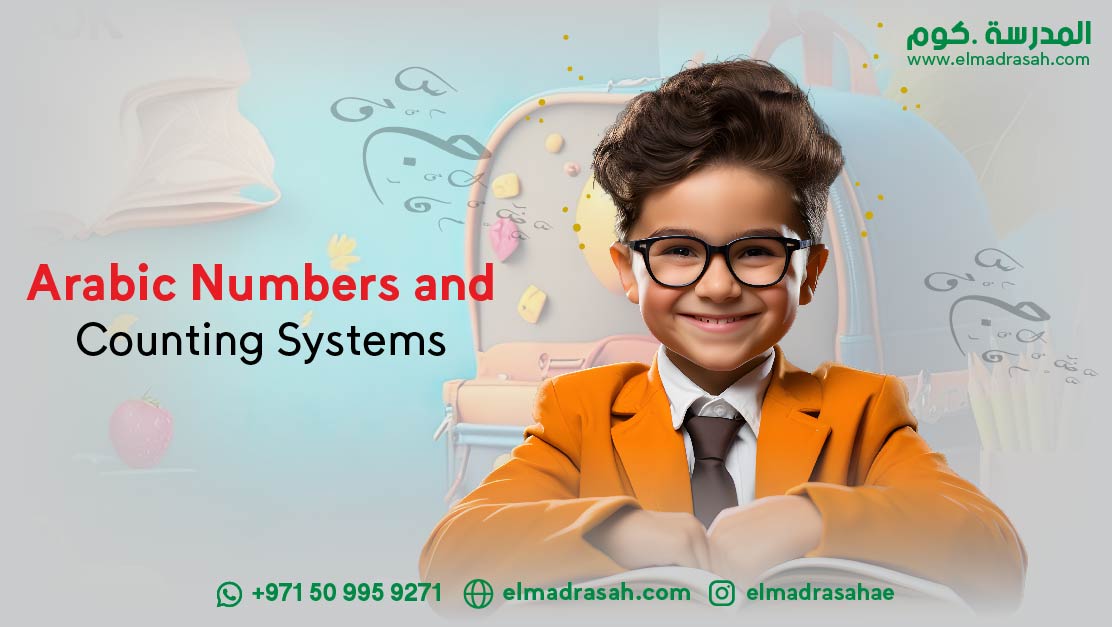
Arabic, a language rich in history and culture, is a fascinating language to explore, not only for its intricate grammar and eloquent idioms but also for its unique numerical system. Arabic numbers and counting systems offer a captivating journey into the world of Arabic culture, mathematics, and linguistics. In this article, we will delve into the intricacies of Arabic numbers, their pronunciation, and how learning Arabic can be a rewarding experience for non-native speakers. We will also touch upon the educational resources provided by Elmadrasah.com, an online platform dedicated to teaching Arabic to learners worldwide.
The Arabic Numerical System: A Brief Overview
Arabic numerals, often referred to as Hindu-Arabic numerals, are the ten digits (0-9) that have become the standard for most of the world’s mathematical and numerical communication. However, it might come as a surprise to many that these numerals have a deep-rooted connection with the Arabic language.
Arabic numbers are written and read from left to right, just like English numerals. They are composed of the following ten basic digits:
(١٢٣٤٥٦٧٨٩٠)
١
٢
٣
٤
٥
٦
٧
٨
٩
٠
The Arabic numerical system employs a base-10 system, which means that each digit’s value depends on its position within a number. For example, when you write the Arabic numeral -١٢٣,- the first digit (from the right) represents one hundred, the second digit represents twenty, and the third digit represents three. When pronounced as a whole, -١٢٣- becomes -mi’ah wa-‘ishrin wa-thalath.-
Arabic Pronunciation of Numbers
Arabic pronunciation of numbers is a crucial aspect of understanding the Arabic language, and it’s essential for non-native speakers to grasp this aspect for effective communication. Let’s delve into more detail about how Arabic numbers are pronounced, as well as some nuances and variations in pronunciation.
Cardinal Numbers: Arabic cardinal numbers represent the basic counting numbers from 1 to 10, and they are fundamental for any Arabic learner.
١ – واحد (waahid): The number 1 is pronounced as -waahid.- It’s important to note that the -w- sound is produced by rounding the lips. This sound is somewhat similar to the -w- sound in English.
٢ – اثنان (ithnaan): The number 2 is pronounced as -ithnaan.- Pay attention to the -th- sound, which is distinct from English. The -th- sound is produced by lightly placing the tip of the tongue against the upper front teeth.
٣ – ثلاثة (thalaathah): Number 3 is pronounced as -thalaathah.- Again, this involves the distinctive -th- sound.
٤ – أربعة (arba’ah): The number 4 is pronounced as -arba’ah,- with the -r- sound having a slight guttural quality. The -a- is pronounced as in -car.-
٥ – خمسة (khamsah): Number 5 is pronounced as -khamsah,- with the -kh- sound being a throaty sound unique to Arabic.
٦ – ستة (sittah): The number 6 is pronounced as -sittah.- Pay attention to the -s- and -t- sounds.
٧ – سبعة (saba’ah): Number 7 is pronounced as -saba’ah.- The -b- and -s- sounds are notable.
٨ – ثمانية (thamaaniyah): The number 8 is pronounced as -thamaaniyah.- Again, the -th- sound is used.
٩ – تسعة (tis’ah): Number 9 is pronounced as -tis’ah.- The -t- sound is clear in this pronunciation.
٠ – صفر (sifr): The number 0 is pronounced as -sifr.- The -s- sound and -f- sound are easily recognizable in this pronunciation.
Additional Points to Consider:
Pronunciation Variation: The pronunciation of Arabic numbers can vary slightly depending on the region or dialect. For example, the pronunciation of -ث- (the Arabic letter -tha-) may sound slightly different in Egyptian Arabic compared to Gulf Arabic.
Connecting Numbers: When counting from 11 onwards, you will notice that Arabic numbers use a combination of the basic numbers. For instance, 11 is -احد عشر- (ihda ‘ashar), which essentially means -one ten.-
Accent Emphasis: Arabic pronunciation involves accent emphasis on certain syllables. Understanding these accents is essential to speak fluently and be understood by native speakers.
Learning Resources: To master the pronunciation of Arabic numbers, consider using language learning resources like Elmadrasah.com, an online platform dedicated to teaching Arabic to non-native speakers. These resources typically include audio and video materials that guide learners through correct pronunciation. They may also offer interactive exercises to practice numbers and their pronunciation in real-life contexts.
Arabic numbers and their pronunciation are fundamental elements of the Arabic language that non-native speakers must learn to communicate effectively. While the pronunciation may seem daunting at first, practice, exposure to native speakers, and dedicated language learning resources like Elmadrasah.com can greatly aid in mastering this aspect of the Arabic language. Remember that learning Arabic numbers opens doors to a deeper understanding of the Arabic culture and facilitates travel, business, and social interactions in the Arab world.
Arabic Idioms Incorporating Numbers
Arabic idioms incorporating numbers are not only linguistically fascinating but also offer unique insights into the culture and mindset of Arabic speakers. These idioms are more than just linguistic expressions; they reflect the historical, social, and even religious aspects of the Arabic-speaking world. Let’s explore some of these idioms in more detail:
-بين القليل والكثير- (Bayn al-Qaleel wal-Katheer): Translated as -between little and much,- this idiom is a reflection of the Arabic mindset when it comes to moderation and balance. In many Arabic cultures, balance is highly valued, and this idiom serves as a reminder of that. It is often used when discussing a moderate amount of something, emphasizing the idea that neither too much nor too little is desirable.
-مرة واحدة في العمر- (Marrah Waahidah fi al-‘Umr): This idiom translates to -once in a lifetime.- It is used when referring to rare or extraordinary events or experiences. It highlights the idea that some events are so unique that they may only occur once during a person’s entire life.
-ثلاث مرات وكفى- (Thalath Marrat Wakfah): When someone wants to emphasize that they’ve had enough of a particular situation or experience, they might use this idiom, which means -three times is enough.- The number three holds significance in many cultures, including the Arabic-speaking world, and it symbolizes a complete cycle or sufficiency.
-أربع عيون وراء رأسي- (Arba’ ‘Uyoon Waraa Raasi): This idiom, which means -four eyes behind my head,- is used to indicate that someone is watchful, vigilant, or very observant. The number four is often associated with being thorough or comprehensive in Arabic culture.
-سبع أبواب للخير- (Saba’ Abwaab lil-Khayr): Translating to -seven doors to goodness,- this expression highlights the idea that there are numerous paths to good fortune or success. The number seven is often considered lucky in many cultures, including the Arab world, and is associated with completeness and prosperity.
-على القدم والسلام- (Ala al-Qadam wa-Salaam): This idiom means -on the foot and peace.- It is used when someone leaves in a hurry or without taking anything with them. It suggests a sudden departure without any belongings, emphasizing the swift nature of the departure.
-بسبع خطوات يصنع الأمل- (Bi-Saba’ Khutwaat Yusna’ al-Amal): Translating to -with seven steps, hope is made,- this idiom conveys the idea that small, consistent efforts can lead to the creation of hope and optimism. It highlights the significance of taking gradual, measured steps toward achieving one’s goals.
-خمسة ولا ثمانية- (Khamsah Wala Thamaaniyah): This idiom means -neither five nor eight.- It is often used to express the idea that something is not easily categorized or falls between two extremes. It emphasizes the need to consider the nuances and complexities of a situation.
These Arabic idioms incorporating numbers provide a unique window into the Arabic culture’s values, beliefs, and perceptions. Understanding these idioms can help learners of the Arabic language gain a deeper appreciation for the language and its cultural richness. It also allows non-native speakers to connect with Arabic speakers on a more profound level, fostering better communication and cultural understanding.
Learning Arabic for Non-Native Speakers
Learning the Arabic language as a non-native speaker is a challenging yet immensely rewarding endeavor. Arabic is a language of deep historical and cultural significance, spoken by millions across the Arab world and beyond. Here, we’ll delve into the various aspects of learning Arabic for non-native speakers, highlighting its importance, challenges, and strategies for success.
Why Learn Arabic as a Non-Native Speaker?
Cultural Enrichment: One of the most compelling reasons to learn Arabic is the opportunity to immerse yourself in the rich and diverse Arabic culture. The Arab world has made significant contributions to art, literature, music, and cuisine. Learning the language provides a gateway to understanding the cultural intricacies that have shaped this region.
Global Relevance: Arabic is one of the world’s most widely spoken languages, with over 300 million native speakers. Additionally, Arabic is an official language in 26 countries and is a prominent language in international diplomacy and trade, making it a valuable asset for individuals in various professions.
Business Opportunities: The Middle East and North Africa are becoming increasingly significant players in the global economy. Knowing Arabic can open doors for international business, trade, and cooperation. Being able to communicate with Arabic-speaking partners or clients can give you a competitive edge in the business world.
Career Advancement: Many government agencies, international organizations, and corporations seek individuals with Arabic language skills for positions related to diplomacy, translation, intelligence, and international relations. A solid command of Arabic can enhance your career prospects.
Travel and Exploration: Traveling to Arabic-speaking countries becomes a more immersive and enjoyable experience when you can communicate with locals in their language. You can navigate local markets, understand cultural norms, and create deeper connections with the people you meet.
International Relations: In a world where Arabic-speaking countries often play pivotal roles in global affairs, understanding the language and culture is essential for those interested in international relations, conflict resolution, and peace-building efforts.
Challenges of Learning Arabic
Learning Arabic for non-native speakers can be challenging due to several factors:
Alphabet and Script: The Arabic script is quite different from the Latin script used in English. Learning a new script can be intimidating, but with practice, it becomes manageable.
Complex Grammar: Arabic grammar is highly structured and features intricate rules and verb conjugations. Understanding these rules can be challenging, but it’s crucial for proficient communication.
Dialect Variation: Arabic has many dialects, and the spoken language can vary significantly from one region to another. While Modern Standard Arabic (MSA) is the formal written language, many people in daily life use local dialects. This dialectical variation can be confusing for learners.
Vocabulary Differences: Arabic vocabulary is distinct from English, which means building a solid Arabic vocabulary is essential for effective communication.
Strategies for Learning Arabic
Structured Learning: Consider enrolling in a formal Arabic language course, whether at a language school or through online platforms like Elmadrasah.com. These courses provide a structured curriculum and access to experienced instructors.
Immerse Yourself: Surround yourself with the language. Watch Arabic films, listen to Arabic music, and read Arabic books. This exposure will help you get accustomed to the sounds, rhythm, and colloquial expressions.
Practice Regularly: Consistency is key. Practice your Arabic skills daily, whether it’s speaking, writing, or listening. Language skills improve with continuous practice.
Engage with Native Speakers: Engaging with native speakers can accelerate your learning. Consider language exchange partners, conversation groups, or online platforms that connect you with Arabic speakers.
Use Language Apps: Language learning apps like Duolingo, Memrise, or Rosetta Stone offer Arabic courses that can be an excellent complement to your learning.
Travel or Study Abroad: If possible, spending time in an Arabic-speaking country or studying abroad can be a transformative experience. It immerses you in the language and culture, providing an opportunity for rapid progress.
Set Realistic Goals: Set achievable milestones for your language learning journey. Whether it’s holding a simple conversation, reading a newspaper article, or giving a presentation, having specific goals can keep you motivated.
Be Patient: Learning Arabic is a long-term commitment. There will be challenges and moments of frustration, but remember that every small achievement brings you closer to fluency.
Learning Arabic as a non-native speaker offers a gateway to a world of culture, business, and international relations. Despite its challenges, the rewards of mastering the Arabic language are vast. By following structured learning, immersing yourself in the language and culture, and persevering through the hurdles, you can achieve proficiency in Arabic, expanding your horizons and enriching your life in the process. Platforms like Elmadrasah.com provide valuable resources and courses to support your journey towards learning this captivating language.
Elmadrasah.com: Your Gateway to Arabic Language Learning
Elmadrasah.com is a reputable online platform dedicated to teaching the Arabic language to learners worldwide. With a commitment to providing high-quality education, Elmadrasah.com offers a range of courses that cater to both beginners and advanced learners.
Their courses include:
Arabic Language Basics: These courses are designed for absolute beginners who want to build a strong foundation in Arabic. Students learn the Arabic alphabet, basic grammar, and essential vocabulary.
Conversational Arabic: For those interested in becoming proficient in spoken Arabic, Elmadrasah.com offers conversational Arabic courses that focus on day-to-day language use, essential expressions, and common phrases.
Arabic for Business: This course is tailored for professionals who want to communicate effectively in the business context. It covers business-related vocabulary, etiquette, and communication skills.
Advanced Arabic Studies: For students with a more extensive background in Arabic, there are advanced courses that delve into literature, media, and more complex grammar and vocabulary.
Cultural Insights: Elmadrasah.com understands the importance of culture in language learning. They offer courses that provide insights into Arabic culture, customs, and traditions to help learners gain a holistic understanding of the language.
Arabic Numbers and Counting: For those who want to master the Arabic numerical system and counting, Elmadrasah.com offers dedicated courses that cover the intricacies of Arabic numbers, their pronunciation, and their cultural significance.
Conclusion
Arabic numbers and counting systems are an integral part of the Arabic language and culture. Learning Arabic can be a fulfilling experience for non-native speakers, offering opportunities for cultural enrichment, business growth, and personal development. Elmadrasah.com provides a valuable platform for learners of all levels to explore the beauty of the Arabic language and its numerical system. Whether you aim to travel, conduct business, or simply connect with Arabic speakers, the knowledge of Arabic numbers and the language itself is a doorway to a world of endless possibilities. Start your Arabic learning journey today and unlock the richness of the Arabic language and culture with Elmadrasah.com.















